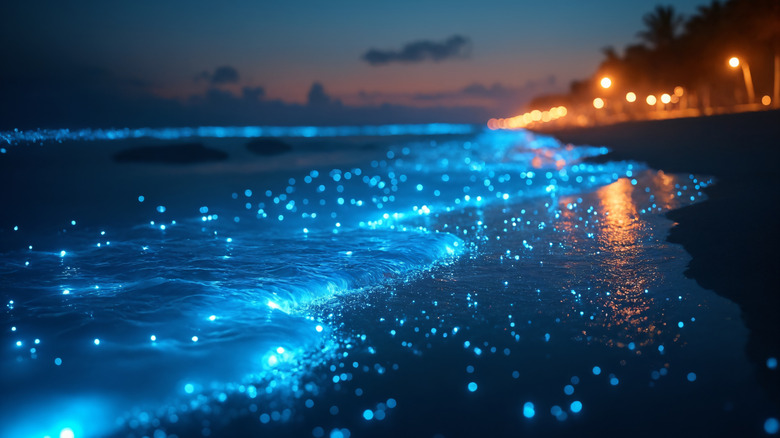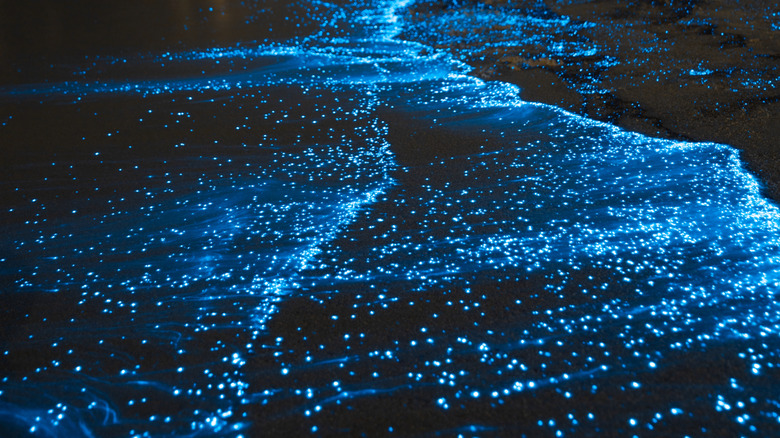
Picture this: You're walking along the shore of one of the most famous beaches in the world, not just for its white sands and clear waters, but for the surreal electric blue glow that seems to mirror the skies above. This spectacle isn't from a sci-fi blockbuster, but is commonly known as the "Sea of Stars," an effect created by the bioluminescent plankton Lingulodinium polyedrum. These unassuming organisms turn into gorgeous light shows when they're agitated by water movement, with the effect mesmerizing
travelers from around the world who flock to the Maldives for a chance to see it.
So how does it work? To get that iconic glow, microscopic dinoflagellates have a chemical called luciferin, which, when disturbed, releases "cold light," or light that radiates without heat. These organisms thrive in warm waters, like those in the Maldives. And when conditions are just right (and human movement stirs the plankton), they quite literally shine and appear as luminous ripples throughout the shoreline.
While it's possible to witness the Sea of Stars across the Maldives, it has become most commonly associated with Vaadhoo Island, which went viral in the 2010s for this phenomenon. The same effect has been reported on islands like Thoddoo, Fulidhoo, and even near the capital Malé, but none quite live up to Vaadhoo's perfect blend of low light pollution, accessible beaches, and community-run guesthouses. These have turned it into the destination synonymous with the Sea of Stars, with visitors coming from near and far to wade in the starry blue light.
Read more: The Most Tourist-Friendly Countries In The World, According To Travelers
How To Catch The Sea Of Stars

Most tourists think the best time to visit the Maldives is when it's dry and pleasant, but for the biggest chance at catching the Sea of Stars in all its glory, the best time to go is during the southwest monsoon. From April to October, the weather is just right for nutrient-rich currents to fuel plankton blooms. It's even better if you can time your visit during the new moon, with the darkness helping the bioluminescence truly shine.
For international travelers, the journey begins at Velana International Airport in the capital city of Malé, the main gateway into the Maldives. From there, visitors bound for Vaadhoo Island typically catch a domestic flight to Maafaru Airport or Funadhoo Airport, which are both located near Raa Atoll and take about an hour. Upon landing, you'll need to take a ferry to Vaadhoo. Try to select accommodations as close to Vaadhoo's beaches as possible, such as locally run guesthouses like Vaadhoo View Inn. The locals who run these businesses can likely offer more guidance about the best nights to walk the shore or even book night snorkeling tours for those who want to get even more up close and personal with the plankton.
From the beach, though, the ideal time to catch the glowing organisms is right after sunset and into the night. Get comfortable with the darkness and keep stirring the water with your hands or perhaps toss a pebble, as any type of disturbance can trigger the plankton. You don't need to pack much for a successful beach trip here, as you'll have to rely on key timing and good luck. By choosing the right season, timing your visits under moonless skies, staying beachside, and entering the water, you'll give yourself a shot at experiencing one of the Maldives' most extraordinary natural gifts.
Ready to discover more hidden gems and expert travel tips? Subscribe to our free newsletter for access to the world's best-kept travel secrets.
Read the original article on Islands.











